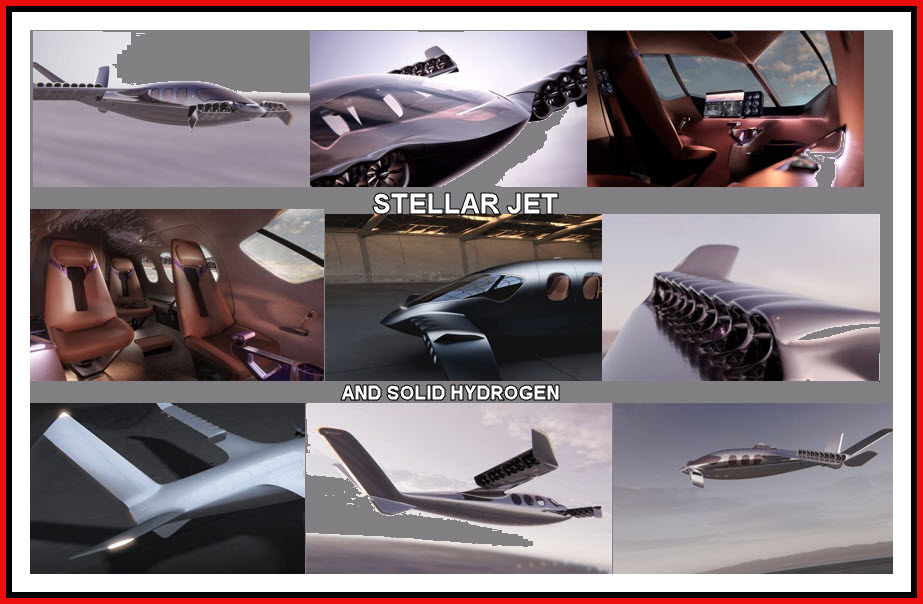Solid Hydrogen as power source in an eVTOL- a real advance???

Stellar Jet thinks so!!!
Sustainability Times has published a fascinating article[1] about a Texas start-up that may well be a breakthrough in the regional aircraft sector. According to the author the disruptive technology involves applying GROUNDBREAKING SOLID HYDROGEN STORAGE UNIT AND ELECTRIC PROPULSION SYSTEM to this class of aircraft with a shorter haul mission. A multitude of electric propulsion systems are being touted as Green Solutions; here are a few:
- #electricaircraftNEWS- 1st passenger flight @JFK and then MIT announces new battery technology with 3X Lithium Ion range.
- TWO INDEPENDENT EVENTS SHOW NEW PROMISE FOR ELECTRIC FLIGHT – JDA Journal.
- The apparent leader in regionalePLANE flight laid off its tech staff–-WHY is an important QUESTION for the GREEN AVIATION goal!!!
- Slovenia/USA first flight of an autonomous hybrid-electric VTOLPIPISTRELL reaches a MILESTONE IN THE eVTOL sector – JDA Journal–BIG DEAL???
- This #GREEN aviation wave depends on new #ENERGY– an exciting development?
- Quieter, no CO2 emissions, lower operating costs– #Alicecomes to #CapeAir for regional flights to be adored by the neighbors and passengers
This list has yet to include any certificatable, economic and ready airplanes; WHY DOES STELLAR JET APPEAR TO BE DIFFERENT?
StellarJet has a demonstrator undergoing validation and likely to have its first flight this summer. Research failed to find any third party evaluations. Here are the company’s information about the company and the plane:
Those are promising parameters for this aircraft. A type certification for a unique, innovative aircraft will test the FAA staff’s ability to define the criteria and airworthiness tests. Then and only then will these expected values have meaning. Help from a team that is current on the evolving FAA standards might be helpful.
StellarJet, a pioneering startup in the aerospace industry, is set to unveil its groundbreaking solid hydrogen storage unit and electric propulsion system at the Salon du Bourget 2025, promising to revolutionize aviation technology with enhanced safety, efficiency, and sustainability.
In the rapidly evolving world of aviation technology, StellarJet, a Texas-based startup, is pioneering groundbreaking advancements that promise to reshape the industry. With their innovative solid hydrogen[2] storage unit[3] and a new electric propulsion system[4], StellarJet is poised to demonstrate these cutting-edge technologies at the upcoming Salon du Bourget 2025. As these developments unfold, the aviation community is abuzz with anticipation over the potential implications for future aircraft design and environmental sustainability.
Breaking New Ground with Solid Hydrogen Storage
StellarJet’s introduction of a SOLID hydrogen storage unit signifies a significant leap forward in aviation fuel technology. Unlike traditional liquid hydrogen storage, this novel solution is based on METAL HYDRIDE TECHNOLOGY, offering a safer and more efficient alternative. The storage unit achieves an impressive energy density of 6.6 kWh/kg and a mass capacity of 23%, operating in temperatures ranging from -76 °F to 176 °F and pressures between 290 psi and 5,076 psi. One of the most enticing features is its rapid refueling capability, allowing for a complete refill in under 30 minutes.
Originally designed for space applications, this technology has now been adapted for various sectors, including aviation and defense. Its modular nature allows for easy integration across different formats, enhancing its versatility and appeal to a wide range of industries. By eliminating the risk of boil-off and using more accessible materials, StellarJet’s storage unit not only enhances safety but also simplifies the certification process, presenting a viable solution for future aviation fuel needs.
[1] Since this involves new technology, the original article has been heavily annotated here and additional images included to aid in learning about this aircraft.
[2] Solid hydrogen is the solid state of the element hydrogen. At standard pressure, this is achieved by decreasing the temperature below hydrogen’s melting point of 14.01 K (−259.14 °C; −434.45 °F). It was collected for the first time by James Dewar in 1899 and published with the title “Sur la solidification de l’hydrogène” (English: On the freezing of hydrogen) in the Annales de Chimie et de Physique, 7th series, vol. 18, Oct. 1899. Solid hydrogen has a density of 0.086 g/cm3 making it one of the lowest-density solids.
[3] This innovative fuel tank utilizes metal hydride technology to store hydrogen, offering a safer and more efficient alternative to traditional liquid hydrogen systems. The SSHSU boasts a 23% hydrogen weight content, 6.6 kWh/kg energy density, and operates safely at pressures between 20-350 bar and temperatures from -60°C to +80°C
[4] The Stellar Jet boasts a hydrogen-electric (hybrid) propulsion system with a fuel tank, enabling significantly extended flight distances. Offering a remarkable range of up to 1150 miles, it far exceeds the capabilities of fully electric eVTOLs, which typically max out at around 150 miles